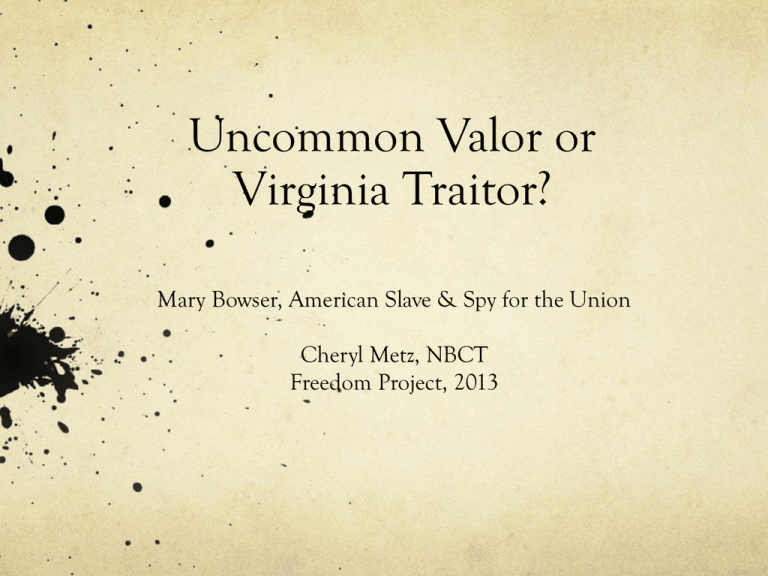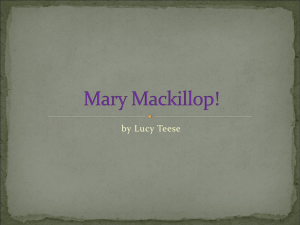Uncommon Valor or Virginia Traitor?
advertisement

Uncommon Valor or Virginia Traitor? Mary Bowser, American Slave & Spy for the Union Cheryl Metz, NBCT Freedom Project, 2013 Virginia Slave Laws …all children born in this country shall be held bond or free only according to the condition of the mother (1662) …moderate corporal punishment inflicted by master or magistrate upon a runaway servant shall not deprive the master of the satisfaction allowed by the law (1668) …if any slave resists his master (or other by his master’s order correcting him) and by the extremity of the correction should chance to die, that his death shall not be accounted a felony (1669) Virginia Slave Laws …all negro, mulatto, and Indian slaves, in all courts of judicature, and other places, within this dominion, shall be held, taken, and adjudged, to be real estate (1705) Any white person assembling with slaves or free Negroes for purpose of instructing them to read or write, or associating with them in any unlawful assembly, shall be confined in jail not exceeding six months and fined not exceeding $100.00. (1848) Black Contributions to Civil War "Black Dispatches" was a common term used among Union military men for intelligence on Confederate forces provided by Negroes. This source of information represented the single most prolific and productive category of intelligence obtained and acted on by Union forces throughout the Civil War. Rose, 2007 "The chief source of information to the enemy is through our Negroes.” Robert E. Lee, 1863 U. S. War Department, The War of the Rebellion: A Compilation of the Official Records of the Union and Confederate Armies. Washington, DC: Government Printing Office; 1880-1901, Vol. 25, Part 2, p. 826 (Lee to Critcher, 22 May 1863) Black Contributions to Civil War The true history of this war will show that the loyal army found no friends at the South so faithful, active, and daring in their efforts to sustain the government as the Negroes-. Negroes have repeatedly threaded their way through the lines of the rebels exposing themselves to bullets to convey important information to the loyal army of the Potomac. Frederick Douglass, 1862 Markle, Donald E. Spies and Spymasters of the Civil War. New York: Hippocrene Books, 1995; pp. 64-65 The Van Lew Family John Van Lew, a wealthy hardware merchant in Richmond, Virginia, owned a number of slaves. Van Lew's daughter, Elizabeth, freed all her father's slaves after he died after convincing her mother it was the right thing to do. Miss Van Lew, or “Crazy Bett” as some called her, became a spy for the Union Forces and was instrumental in fighting for the abolition of slavery, even though she didn’t consider herself an abolitionist. The Van Lew Family "You have sent me the most valuable information received from Richmond during the war.” Ulysses H. Grant Content from letter sent to Elizabeth “I was never an abolitionist. Abolitionists are fanatics who will stop at nothing to achieve their goals. I have always spoke out against slavery, for which I paid dearly in the loss of many friends. But I was never a fanatic.” The Van Lew Family HEADQUARTERS EIGHTEENTH ARMY CORPS FORTRESS MONROE, February 5, 1864 HONORABLE E.M. STANTON, Secretary of War, Sir, I send enclosed for your perusal the information I have acquired of the enemy’s forces and disposition about Richmond. The letter commencing “Dear Sir,” on the first page, is a cipher letter to me from a lady in Richmond with whom I am in correspondence. The bearer of the letter brought me a private token showing that he was to be trusted. . . You will see that the prisoners are to be sent away to Georgia. Now or never is the time to strike . . . I have marked this “Private and immediate,” so that it shall at once come into your hands. Respectfully your obedient servant, BUTLER, BENJ. P. Maj.-Gen. Comanding The Van Lew Family Dear Sir, It is intended to remove to Georgia all the Federal prisoners’ butchers and bakers to go at once. They are already known this to be true. Are building batteries on the Danville road. This from Quaker: Beware of new and rash council! Beware! This I send you by direction of all your friends. No attempt should be made with less than 30,000 cavalry, from 10,000 to 15,000 to support them, amounting in all to 40,000 or 45,000 troops. Do not underrate their strength and desperation. Forces could probably be called into action in from five to ten days’ 25,000, mostly artillery. Hoke’s and Kemper’s brigades gone to North Carolina: Pickett’s in or about Petersburg. Three regiments of cavalry disbanded by General Lee for want of horses. Morgan is applying for 1,000 choice men for a raid. Official Records of the Union and Confederate Armies. [Series I; Vol. XXXIII, Part I, page 520] The Van Lew Family Mary Bowser, born into slavery in Virginia sometime around 1840, was born to a slave in the Van Lew household. “On May 17, 1846, ‘Mary Jane [Richards], a colored child belonging to Mrs. Van Lew,’ was baptized in St. John’s, the stately Episcopal church for which the elegant Church Hill neighborhood of Richmond is named, and in which Patrick Henry delivered his 1775 ‘give me liberty or give me death’ speech.” NY Times June 21, 2012 Mary Elizabeth Richards Van Lew Bowser She was sent north to attend school in Philadelphia at the Quaker School for Negroes, paid by the Van Lew family. In 1855, Bett arranged for the girl, then using the name Mary Jane Richards, to join a missionary community in Liberia. She was miserable there and returned after 1 year. She went back to work in the Van Lew household, and married Wilson Bowser in April 1861. With the formal education she received, Mary was a fine writer and reader, which when combined with a photographic memory, made her perfect for helping Bett gather information for the Union. Mary Bowser Van Lew credited her family’s former slave as her best source, writing in the private diary she kept during the war, “When I open my eyes in the morning, I say to the servant, ‘What news, Mary?’ and my caterer never fails! Most generally our reliable news is gathered from negroes, and they certainly show wisdom, discretion and prudence which is wonderful.” NY Times, 2012 Mary Bowser Elizabeth used her connections to get Mary Bowser a servant job in President Jefferson Davis' Confederate White House. …1900, when Van Lew was dying, a Richmond newspaper’s account of her life included a description of an unnamed “maid, of more than usual intelligence” who was educated in Philadelphia and then placed in the Confederate White House as part of Van Lew’s spy ring. NY Times, 2012 Mary Bowser LECTURE BY A COLORED LADY. -- Miss RICHMONIA RICHARDS, recently from Richmond, where she has been engaged in organizing schools for the freedmen, and has also been connected with the secret service of our government, will give a description of her adventures, on Monday evening, at the Abyssinian Baptist Church, Waverley-place, near Sixth-avenue. NY Times September 10, 1865 Mary Bowser …in 1867, when she met Harriet Beecher Stowe, the Rev. Charles Beecher and the Rev. Crammond Kennedy of the Freedmen’s Bureau. The trio was traveling through St. Mary’s, Ga., when they encountered “a most interesting school taught by a colored girl — quite a character,” who at that time went by the name Mary J. R. Richards. Harriet Beecher’s diary Mary Bowser She left a diary, a diary that McEva Bowser may have found in 1952 when her husband's mother died. McEva Bowser: "I was cleaning her room and... I ran across a diary but I never had a diary and I didn't even realize what it was... And I did keep coming across (references to) Mr. Davis. And the only Davis I could think of was the contractor who had been doing some work at the house. And the first time I came across it I threw it aside and said I would read it again. Then I started to talk to my husband about it but I felt it would depress him. So the next time I came across it I just pitched it in the trash can." NPR, 2002 Mary Bowser “I felt that I had the advantage over the majority of my race both in Blood and Intelligence, and that it was my duty if possible to work where I am most needed.” 1867 correspondence with the superintendent of education for Georgia’s Freedmen’s Bureau I wish there was some law here, or some protection. I know the southerners pretty well … having been in the service so long as a detective that I still find myself scrutinizing them closely. There is … that sinister expression about the eye, and the quiet but bitterly expressed feeling that I know portends evil … with a little whiskey in them, they dare do anything … Do not think I am frightened and laugh at my letter. Anyone that has spent 4 months in Richmond prison does not be so easily frightened. Writing prior to leaving school for Georgia Freeman’s Society Mary Bowser In 1995, the U.S. Military inducted Bowser into the U.S. Army Military Intelligence Corps. Hall of Fame with a statement that read: “Mrs. Bowser certainly succeeded in highly dangerous missions to the great benefit of the Union effort. She was one of the highestplaced and most productive espionage agents of the Civil War.” Which source is more reliable? Why? Photo provided by James A. Chambers U.S. Army Deputy, Office of the Chief, Military Intelligence CIA Art for Black Dispatches How difficult was Mary’s work? Read and study the letter at left for 30 seconds. Then see how much of it you can remember to write down as Mary would have at a later time. References Rose, P.K.. Studies in Intelligence. “Black Dispatches: Black American Contributions to Union Intelligence During the Civil War.”https://www.cia.gov/library/center-for-the-study-ofintelligence/csi-publications/books-and-monographs/black-dispatches/ Accessed on June 2, 2013 Virginia History Archives. http://listlva.lib.va.us/cgi-bin/wa.exe?A2=ind0108&L=va-hist&P=2926. Accessed on June 2, 2013. Leveen, Lois. “A Black Spy in the Confederate White House” NYTimes June 21, 2012. http://opinionator.blogs.nytimes.com/2012/06/21/a-black-spy-in-the-confederate-white-house/ Accessed on June 2, 2013 Liberty Letters. http://www.libertyletters.com/resources/civil-war/elizabeth-van-lew-dispatch-tounion.php Accessed on June 2, 2013 NPR. Morning Edition.“The Spy Who Served Me.” April 19, 2002. http://www.npr.org/programs/morning/features/2002/apr/served/ Accessed on June 2, 2013 References NY Times. September 10, 1865. http://www.nytimes.com/1865/09/10/news/general-city-news.html Accessed on June 2, 2013 Library of Congress. Dr. John Brockenbrough House (Confederate White House), 1201 East Clay Street, Richmond, Independent City, VA http://hdl.loc.gov/loc.pnp/hhh.va0517/photos.314334p CIA. Intelligence in the Civil War. https://www.cia.gov/library/publications/additionalpublications/civil-war/Intel_in_the_CW1.pdf Accessed on June 13, 2013 African American National Biography: a joint project of the W. E. B. Du Bois Institute for African and African American Research at Harvard University and Oxford University Press http://www.fas.harvard.edu/~aanb/SHTML/DOWNLOADS/Sample%20entries%20for%20Web% 20site.pdf https://www.cia.gov/library/center-for-the-study-of-intelligence/csi-publications/books-andmonographs/black-dispatches/boswer.jpg






